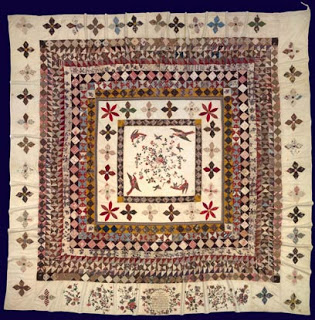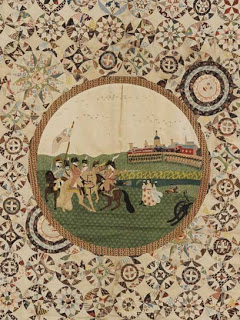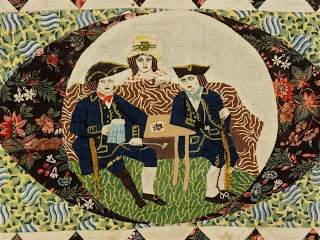While trapped in London during April’s volcanic ash “Travel Chaos”, I went to see the V&A’s fantastic Quilts exhibition. The place was jammed with ladies of a certain age, all giving the impression they were rocking twin-set and pearls even if they weren’t doing so literally. I wonder did the V&A make a deal with Britain’s Womens’ Institutes?
What struck me about the quilts on show was how valuable they ought to be as pieces of socio-economic history, and what a shame it is womens’ crafts have been assigned only an emotional value. For one thing, you can tell an enormous amount about the wealth of the maker. Quilts are generally made with scraps of fabric that the household would have left over from the making of clothing and other soft furnishings. Thus if a quilt is made of scraps of silk you can assume that the household it came from was fairly wealthy.
The stories attached to each quilt reflect family connections, social aspirations and political affiliations as well as more typical rites of passage such as marriages, births and deaths.
It is the intertwining of the personal and the political that makes the exhibition so intriguing. Take the quilt below, which shows King George III reviewing the troops, dated 1803-1805. Not only is it a fabulous piece of propaganda, it is also a record of its maker’s thwarted ambitions.
From V&A curator Sue Prichard’s blog:
“Perhaps more intriguing … is the image of a feisty young woman who has stitched her portrait into several of the most pertinent scenes. Who is this woman – so bold, so brave, and so insolent as to stitch herself into history? Why didn’t she simply sign and date the piece like so many before and indeed afterwards? This is not a typical stitcher, content to sit by the fireside gossiping with her companions. This woman, a red haired beauty, has aspirations; her passions aflame with a desire to experience the wider world, a man’s world…”
So, inspired by the exhibition, I’ve started work on a patchwork quilt. It is decidedly apolitical and a little unambitious in comparison to the fantastic work in the V&A. It consists of scraps of old shirt cotton, Irish Linen and silk in an Art Deco-ish style. I will not be signing it; I will not be embroidering a self-portrait; I am content for it to exist as a warm and sentimental thing.
Oh, and many many thanks to Catherine and Gonzo O’Neill for the booze ‘n’ bed for the night, and to Aengus and Linda McMahon for same. X
Duvet Days Reading:
“The Woman Who Shot Mussolini” by Frances Stonor Saunders.
Saunders’ writing is initially a little flowery, but this is a cracking story about the Honourable Violet Gibson, daughter of Lord Ashbourne, Lord Chancellor of Ireland, who attempted to assassinate Benito Mussolini in 1926 and was condemned without trial to a lunatic asylum where she died in 1956.
Click here to buy



